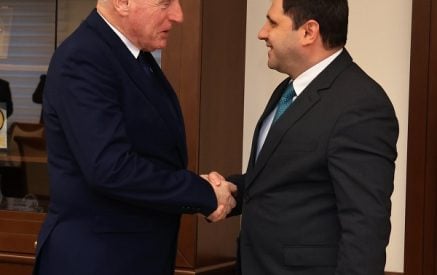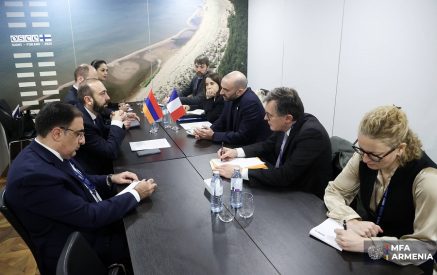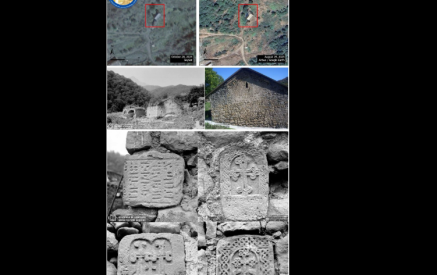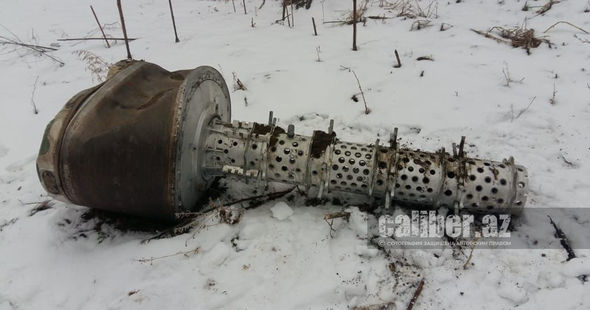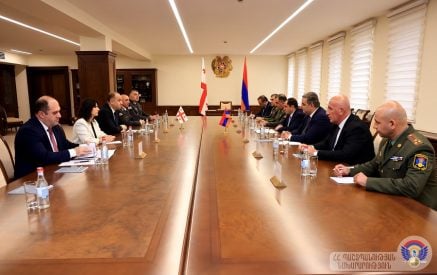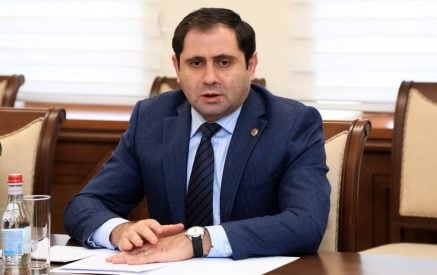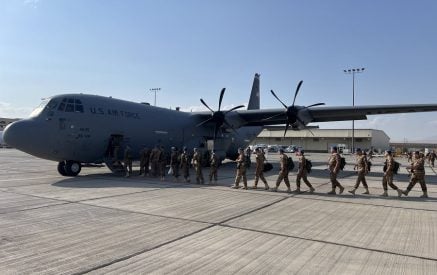Azerbaijan’s National Agency for Mine Action (ANAMA) has published new proof that the Armenian Armed Forces fired Russian-made Iskander missiles at Shushi in the final days of the 2020 Artsakh War.
ANAMA shared pictures of fragments of two exploded missiles along with their coordinates in Shushi. The fragments bear the identification number 9M723, which corresponds to the 9K720 Iskander surface-to-surface short-range ballistic missile system. They were discovered during a land-mine clearance operation on March 15.
Armenian, Russian and Azerbaijani authorities have denied Armenia’s use of the Iskander system during the war. On February 25, 2021 the Russian Defense Ministry immediately rebutted PM Nikol Pashinyan’s claim that the Iskander missiles “didn’t explode—or maybe 10 percent of them exploded,” asserting that the Iskander system was not used during the war and that the Armenian leader had been “misled.” The PM’s office subsequently walked back his statement, admitting that Pashinyan “hadn’t been briefed correctly regarding the situation.” President Ilham Aliyev echoed during a press conference that Azerbaijan had not recorded the use of the Iskander system during the war.
Read also
PM Pashinyan’s criticism of the missile responded to a televised interview with former president Serge Sarkisian on February 16, during which Sarkisian lambasted the current administration for reserving use of the Iskander system for the final days of the war rather than firing at Azerbaijani targets during earlier critical stages.
Evidence that the Armenian Armed Forces fired the Iskander system against Shushi has been circulating since November. Hours before PM Pashinyan announced the ceasefire agreement on November 9, a video surfaced on social media that seemed to show the launch of an Iskander missile in the direction of Azerbaijan. During a press conference following the end of the war, retired General Movses Hakobyan confirmed that the Iskander system had been used during the conflict, although he refused to mention its target. On November 23, far-right anti-government blogger Artur Danielyan shared a video purporting that the Iskander missile had been fired at Shushi on the morning of November 7.
The Fact Investigation Platform, an independent fact-checking media group, studied the video shared on November 9 and verified that the Armenian Armed Forces had deployed the Iskander system, contrary to the claims of the governments of Russia and Azerbaijan. The Armed Forces of Armenia and Artsakh possess three types of tactical operational missiles: OTR-21 Tochka, R-17 Elbrus (“Scud-B”) and 9K720 Iskander. Tochka and Elbrus each carry one missile and require at least 15 minutes to recharge, while the Iskander system carries two missiles that can be fired in succession. The circulated footage clearly shows the same system firing two missiles within 41 seconds, which is within the capability of the Iskander system.
Armenia was the first country to purchase the Iskander-E export variant of the ballistic system from Russia in 2016. Iskander-E has a range of 280 km (174 mi) and a warhead capacity of 480 kg (1058 lbs). However, the missile fragments depicted in the photos published by ANAMA are associated with the non-exportable Iskander-M variant, which is in service exclusively with the Russian military. Iskander-M systems have been deployed in Armenia by Russia since 2013, although it is unclear whether they are in the possession of the Armenian military or they are stationed at the Russian military base in Gyumri. Iskander-M has a range of at least 400 km (246 mi) and a warhead capacity of 700 kg (1543 lbs).
Allegations that Armenia deployed the Iskander system following the entry of the Azerbaijani military to Shushi on November 6 catalyzed the nation’s recent political crisis. On February 24 Pashinyan dismissed First Deputy Chief of the General Staff of the Armenian Armed Forces Tiran Khachatryan after he mocked the PM’s claim that the Iskander missiles had only partially fired during the war. In response, the General Staff of the Armed Forces released an incendiary statement demanding his resignation, joining the ranks of the opposition organized since the end of the war and igniting a standoff between the PM’s administration and the military brass.
PM Pashinyan has announced that the long-awaited snap parliamentary elections will take place on June 20. During an interview with Russian journalist Vladimir Pozner this week, former president Robert Kocharyan affirmed that he will participate in the election for prime minister. He indicated that he would run as the head of a coalition of two political parties; he left the parties unnamed.
Kocharyan also commented on the Artsakh War, asserting that peace cannot be achieved without a just solution. When asked whether he would overturn the results of the 2020 conflict with Azerbaijan, he remarked, “The Armenian army is currently in such a state that no person in sound mind will be thinking of revanche.” He did not specify what the terms of a just solution would look like.
Kocharyan was acquitted by the Yerevan Court of General Jurisdiction this week on charges of “overthrowing the constitutional order,” drawing a dramatic trial that has been ongoing since June 2018 to a close. The acquittal follows a ruling two weeks earlier by the Constitutional Court that the section of Article 300.1 of the criminal code under which Kocharyan was charged is invalid.
Kocharyan’s case addressed his involvement in the violent state crackdown on protesters following Sarkisian’s election in March 2008. Ten people died and hundreds were injured after the national police and military forces were deployed to disperse protesters under Kocharyan’s leadership. He was acquitted this week alongside Seyran Ohanyan, Armen Gevorgyan and Yuri Khatchaturov, the former defense minister, head of the national security council and head of the Yerevan military garrison, respectively.
Alongside Kocharyan’s coalition and the ruling My Step alliance, the two parliamentary opposition parties, the Bright Armenia Party and the Prosperous Armenia Party, have both declared their readiness to participate in the early elections. The Prosperous Armenia Party is a member of the Homeland Salvation Movement, a coalition of 17 political parties that has been demanding the prime minister’s resignation. The coalition has not yet stated its intention to run candidates in the upcoming elections.
“Considering [Pashinyan’s] past, his behavior, there may not be an election,” coordinator of the Homeland Salvation Movement Ishkhan Saghatelyan told reporters. “When he delivers a resignation and a new candidate is not selected within 14 days and parliament is dissolved, then elections will be called, and only then we will think about participating in elections.”
According to a national survey conducted by the International Republican Institute in February, 33 percent of voters would vote for the My Step alliance, three percent for the Prosperous Armenia Party, two percent for Robert Kocharyan, one percent for the Armenian Revolutionary Federation and one percent for the Bright Armenia Party. Meanwhile 44 percent indicated that they would not vote for any of the political parties currently in the running.
During a visit to the Aragats community of the Armavir province on March 28, PM Pashinyan announced that he will resign by the end of April. He plans to continue his responsibilities as prime minister in an interim role until June 20.
Lillian Avedian
Photo Caption: ANAMA claims Armenia’s Armed Forces fired a pair of Iskander missiles during the Artsakh War, March 31, 2021














































